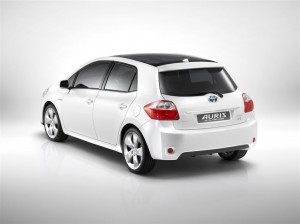In a world premier, Toyota is unveiling the Auris HSD Full Hybrid Concept at the Frankfurt Motor Show.
The Japanese maker says it’s a mainstream model that is the first step in deploying Hybrid Synergy Drive (HSD) across the company’s entire model range. The Aurus shares the same platform as the popular compact Corolla model on sale elsewhere, and uses older nickel metal hydride batteries, as Toyota is still leery of lithium ion technology.
Toyota claims exceptional fuel efficiency and low CO2 emissions for the concept, as do all the other numerous automakers who are looking to comply with pending EU CO2 regulations that require drastic cuts in emissions but give extraordinary credits to electric cars.
Full Hybrid appears to be the latest buzzword for a hybrid that can run on electric power alone for a testing cycle and generate credits for conventional vehicles since proposed tests would say this is zero emissions.
The fallacy here is that it doesn’t take into account how the electricity is generated. In the U.S. for example half of the country’s electric power is generated by burning coal, which generates enormous amounts of pollutants including CO2.
The Auris HSD accelerates from 0-100 km/h in approximately 10 seconds, yet returns “class leading combined cycle fuel economy, and CO2 emissions below 100 g/Km.”
Four driving modes, including ECO, POWER and EV on-demand modes further increase the capabilities of the powertrain.
Toyota claims they help customers develop “relaxed, fuel efficient driving techniques and maximize system efficiency.”
In a clear gimmick that is an energy intensive loser if you take into account the making of the panels, solar panels are applied to the entire roof surface. Inside, dash-top mounted solar panels generate sufficient power to recharge mobile phones or music players mounted in purpose-made charging trays.

